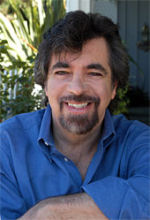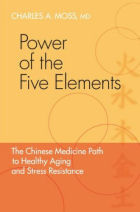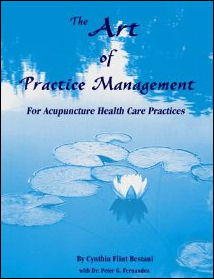Acupuncture & TCM Articles

Neil R. Gumenick is the founder and Director of The Institute of Classical Five-Element Acupuncture. Neil is a Worsley certified advanced teacher of Classical Five-Element Acupuncture and a practitioner with over 27 years of private practice experience. Neil holds three degrees from the College of Traditional Acupuncture (U.K.), and he participated for 10 years in the Master Apprentice Programô, led by Profs. J.R. & J.B. Worsley. Neil has taught at the USC and UCLA Schools of Medicine, the Worsley Institute of Classical Acupuncture, the Traditional Acupuncture Foundation, California Acupuncture College, Santa Barbara College of Oriental Medicine, and Pacific College of Oriental Medicine. He has been a Professor at Emperor's College of Traditional Oriental Medicine and SAMRA University of Oriental Medicine. Neil is co-author of The Art of Practice Management for Acupuncture Health Care Practices
The Initial Consultation: Getting to the Heart of the Matter, Part 4
By Neil Gumenick, MAc (UK), LAc, Dipl. Ac
In previous articles in this series, I discussed the importance of questioning beneath the superficial levels of information given by a patient to discover who the patient truly is - the deeper issues troubling them and how they feel in relation to the presented information.
Everyone has a story (or stories). People with similar stories may be entirely different in their reactions and their relationship to the story. To one patient, a given experience may result in little or no effect. To another, an identical experience may be perceived as devastating. Thus, we must know the individual behind the story, for that is where we must focus treatment if we are to reach the whole person.
 
Treating the Person, Not the Story
No two people with the same or similar story (which may include similar symptoms, labeled syndromes or conditions) are ever treated the same with this system of acupuncture, as we treat the person, not the story. Two patients may have almost identical migraine symptoms, for example, and we will treat them entirely differently. Once we discover and treat the root imbalance, unique to the individual, that is causing the symptoms, Nature will throw out the disease. My teacher, Prof. J.R. Worsley, often reminded us, "No man or woman can heal anything. Only Nature heals, not us. The best we can do is to assist Nature to do what only Nature can do."
Most people in our culture are conditioned to present a mask or façade of a desired "image," rather than reveal their true feelings. In an initial examination, we do not have the luxury of months or years of getting to know our patients and developing trust in such a time frame. We have minutes. In those minutes, with proper rapport skills, we can gain the patient's trust and get behind the facade, and in so doing, also discover the elemental cause (the causative factor) of the disease or condition. Additionally, we can discover the actual points needed to regain balance and harmony, including those intended to reach the levels of mind and spirit. From a state of rapport with the patient, they are most likely to reveal true feelings. Most important, our senses will not clearly perceive the diagnostic indicators of odor, color, sound and emotion.
In prior articles, I discussed the value of observing the patient before they are aware of being observed, the initial physical contact and the arrangement of the treatment room - all with the goal to discover in-depth who the patient is and how to best help them. I discussed how one might inquire into the areas of the patient's name, age, address and occupation. I illustrated how any of these seemingly simple questions could reveal a wealth of information about the patient - at a much deeper level than superficial information.
It is of far less importance what a patient answers than how a patient answers. The "how" gives us real and useful information about a unique individual, leading us to perceive their real needs. The "what" provides simply data and, in itself, tells us nothing about the person. In the method of interviewing proposed here, we question based upon our genuine curiosity about a patient. We use our questions and the patient's subsequent answers to lead us to other deeper questions. This will allow us to reach deeper levels of truth and ultimately, to reach the "heart of the matter."
The Patient's Marital Status
Among my first areas of inquiry, I ask patients their marital status. With this question, I am asking about what is likely the primary relationship in a person's life. Whether a patient is married or not, or has a "significant other" or not, this is an area about which a patient rarely feels neutral.
Whether a person is married or not is of minimal significance. How a person answers the question is extremely significant. Thus, if I ask, "What is your marital status?" and the patient brightens and answers with enthusiasm, "Oh, I've been married for two years. She's my best friend in the world. Don't know what I'd do without her," I am getting far more than information. I am learning about my patient by how they answer.
At the other extreme, the patient may wilt emotionally as they answer, "Yeah, I'm married alright. Seems like I've been married forever." Both of these answers trigger my curiosity, and I may be moved to question deeper: "Tell me what you value most in your relationship" or "It sounds as if you are not very happy in your marriage. Tell me about it." My questions are open-ended, to which a "yes" or "no" answer will not suffice. The questions invite patients to tell me, in their own words, who they are, what needs are being fulfilled (or not), what is important to them and what they value.
There are, of course, a myriad of possible responses to these questions, any and all of which are revealing and diagnostically useful. One patient, for example, may value being loved and having warmth, closeness and intimacy. Another may be single and love it, or long for a committed relationship. Another may feel a deep sense of security knowing their partner is someone on whom they can utterly depend. Another might answer, "She takes care of me better than I take care of myself." We can see that any of these responses provides a still deeper level of insight into the needs and wants of the patient, and could lead to still deeper questioning. I might respond to the last answer by asking, "How do you take care of yourself?"
Additionally, I might ask, "In what way would you like your relationship to be better?" or "What is not working as well as you would like?" No relationship is without its challenges. When one ego clashes with another, as it inevitably will, there are bound to be sparks or explosions. Usually, one's primary relationship provides the greatest opportunities to work on oneself. Our deepest hopes, hurts, disappointments, attachments, expectations and imbalances are often revealed in the experience of the primary love relationship. Thus, what a patient would like in the way of improvement and what is said about their partner are very telling.
Prof. Worsley taught that one of the best ways to learn about people is to listen to how they speak about others, as they are really speaking about themselves. Thus, if a patient becomes sad, their enthusiasm dies out and they answer, "Ever since she went back to work, she doesn't love me anymore. I've been relegated to second place," I have learned something of the patient's own inner life beneath the façade of everything being "fine." The deeper truth revealed in such a statement might be closer to, "Ever since she went back to work, I don't love her anymore. Without her at home reassuring me of her love, I have no love to give to myself."
A Case Study
In the course of an initial examination, I asked a female patient, 27, about her marital status. She replied that she was married. I asked, "For how long?" She replied quietly and matter-of-factly, "18 months." I responded joyfully, "Well, practically newlyweds, aren't you?" She remained strangely silent and was unable to respond with any joy of her own or even sustain eye contact. As the silence became awkward, I gently took her hand and asked, "Would you like to tell me about it?" As the tears came softly, I heard a story of a young woman who had been sexually abused as a child, ran away from home at 17 and had many failed relationships with men (mostly due to them abandoning her for other women). Although she loved her husband, she was unable to trust opening her heart to him, being so terrified of yet another abandonment and, in her imagination, the worst heartbreak yet. She shut herself down for self-protection and in so doing, deprived herself of the very love, joy and intimacy she craved.
Through the methods of traditional diagnosis of odor (scorched), color (lack of red), sound (lack of laugh) and emotion (lack of joy), I determined she was, in fact, a fire-causative factor, predominantly affected on the Heart Protector (Pericardium) and Triple Heater ( San Jiao ) officials. I emphasize that the treatment strategy I implemented was in response to her causative factor and the spiritual trauma she was carrying, not the facts of her story. I have treated other patients with similar stories with completely different reactions and in need of entirely different points. In subsequent questioning of other areas of this patient's life, unrelated to her relationship, the odor, color, sound, and emotion were still present.
Among the points I incorporated into her first treatment plans were the following, which I describe in order to show how we can use points, chosen for their spiritual connotation, to respond to the deepest needs of patients:
Heart Protector (Pericardium) 6
Inner Frontier Gate
Just as its name implies, the Heart Protector's job is to protect the heart, considered by the ancient Chinese to be the emperor, God's representative on Earth. He ruled unselfishly and lovingly, dispensing his wisdom fairly and impartially for the good of all. Were he to be unprotected and in fear of his own survival, he could no longer listen to the needs of all, but would become partial, open to some and closed to others. When the heart is well-protected, it can be open without fear, knowing that those who would be injurious will not be allowed inside this gate.
We all have such a gate within ourselves. When the gate is stuck open, anyone can enter at any time. Without the protection this gate affords, we feel vulnerable and fearful of being hurt, and are often heartbroken. Our inner fire is devastated. Conversely, when this gate is jammed shut, we are overprotected, keeping everyone out, imprisoning ourselves within. Without the love, warmth and joy of interaction, our inner fire goes out, as we live in a state of ever-growing coldness and solitude.
Thus, this gate needs to be opened and closed appropriately, keeping out those who would hurt us while letting in those who bring real love, joy, and intimacy. Treating Inner Frontier Gate on this patient restored its ability to open and close freely, and helped her to open to the genuine love of her husband.
Three Heater (San Jiao) 7
Assembly of Ancestors
The Three Heater official is concerned with maintaining a proper balance of heat among the areas (or "burning spaces") into which the trunk is divided, and in which the officials reside. No official within us can operate optimally if its environment is too hot or cold. Outwardly, the warmth of our relationships in the external world needs to continually adjust and adapt to be in perfect synch and harmony in every situation. This is the essence of relationship - the appropriate giving and receiving of ourselves with another.
In this patient's case, her ability to trust and to know how much of herself could be safely expressed to others had been severely traumatized. She had been hurt so deeply and so often in relationships that she had simply shut down her own fire and developed a cold, impenetrable shell around her. No amount of rational thinking or analysis had helped.
To see and know with whom we are, friend or foe, is more than seeing with physical eyes, or even the mind's eyes. We see truly with the eyes of spirit: Is this someone I can trust, to whom I can open myself? How much opening is appropriate? What is too much? What is too little? How can I tell?
Using the point Assembly of Ancestors on a fire-imbalanced patient is akin to calling a great meeting with their great grandmothers and grandfathers - those who have seen and done it all before, and from a high and heavenly perspective, can give the benefit of wise counsel. We can well imagine the relief of such counsel: "This one is safe," or "Be cautious here." The Chinese revered their ancestors for the wisdom they held and their ability to help those in the land of the living. Whether we hold the concept of "ancestors" in a literal or metaphorical sense - as in the wisdom of our higher selves - tapping into such spiritual wisdom reassures us that we are not on our own. Thus connected, we can see each situation with new eyes and respond with instinctual immediacy, rather than through the veils of past pain. We can attune ourselves appropriately in extending our relationships with others and in society.
This patient, in her short lifetime, had only the benefit of limited experience (albeit painful). She globalized her trauma and trusted no one, including her own husband. Imagine the reassurance and new strength she felt, having access to such a wealth of boundless love and heavenly wisdom from the ancestors to carry into the world.
 
The Art of Practice Management for Acupuncture Health Care Practices
What you will find in this book is a specific, comprehensive approach that gets to the root cause of success in practice.
This new book presents acupuncture practice as art from the standpoint of centering, qi, and wholeness. It builds on the premise that practices succeed from bridging inner and outer aspects of the self. It is an inquiry into the self and addresses clear understandings and approaches to reputable patient care and practice qi. It brings in the five elements and work with the seasons of practice from training and start-up to growth, stability, expansion and transformation. The authors artfully bridges the essence of both patient and practitioner well-being without excluding the practicalities of financial well-being. This book very specifically and extensively shows how the different parts of practice nourish and feed one another and are interdependent on one another for the qi to flow synchronistically.
It explores the dual nature of procedures that work and those which do not in acupuncture health care practice, returning again and again to the delicate balance of practicality and spirituality.
|
